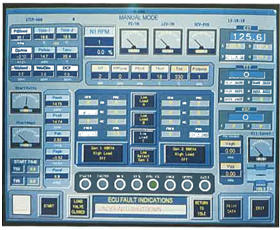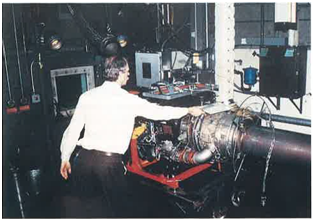United Airlines is one of the world’s largest airlines, flying from 159 airports in the United States and 32 other countries. One of the factors contributing to the company’s success is its willingness to adopt the latest advances in technology to serve its customers. Some advances are obvious, such as jet engines to slash travel times or computerized reservation systems to speed ticketing and seat assignment. However, some of the most significant advances are never seen by the public.
Consider United Airlines’ San Francisco Maintenance Operations Center. It spans 144 acres – over 3 million square feet – and is the largest operation of its kind in the world. The facility maintains everything on the company’s fleet of 550 airliners, from the airframes to the coffee makers.
One of the most important functions the facility performs is the overhaul and testing of jet engines. United has incorporated SL Corporation’s SL-GMS software to provide interactive, visual displays for this critical process.
The maintenance facility at San Francisco has six jet engine test cells. Two are dedicated to engines for wide body aircraft, such as the McDonnell Douglas DC-10 or Boeing 747 and 767. Two other cells test the engines from narrow body aircraft – Boeing’s 727 and 737 type aircraft. The remain ing two test cells are for Auxiliary Power Units (APUs).
The APU is a jet engine that supplies the airplane’s electrical power and air conditioning requirements while it is on the ground, and also air for the main engine starters. The APU is also a redundant source of electrical power in-flight in some aircraft. Just like the main engines, each APU must be periodically torn clown to piece parts and each piece part must be refurbished. The APU is reassembled and tested to insure compliance with the manufacturer’s specifications. The tests include running the APU at full power while measuring its electrical and air flow capacities.
Before United developed the automated test cell utilizing SL-GMS software, testing was conducted manually. The operator would mount the APU in a fixture in a sound proof room and connect the wiring, piping and fuel lines used to run the APU during the test. Then, the operator would go to a second room containing the test cell’s console. The old console had every gauge, meter, switch and light needed to test every aspect of six different engine types. Parameters tested included pressures and temperature, airflow, generator loading, vibration, speeds and electrical power.
This arrangement had serious limitations. First, the operator followed a test script, throwing switches and twisting dials that would operate the APU and step it through a sequence of events, loading and unloading the various systems. This sequence took an average of thirty minutes. However, the timing and sequence was left to the operator’s discretion. The test results were often compromised due to the operator’s inability to read the many dials and gauges simultaneously at points throughout the test sequence.
Further, the operator would manually record the results on preprinted forms and a log sheet. This was a time consuming process.
The test cell also lacked flexibility. If a new type of engine was added to the fleet, holes had to be drilled in the console for the additional dials and switches. Similarly, if engineers wanted to test additional parameters on an existing APU, more gauges would have to be installed.
United decided to develop a new, automated test system for APUs that would eliminate variability from test results. Also, the new system would be required to test all current engine types. Plus, it would be flexible enough to be easily adapted to the two or three new fleets targeted for acquisition in the 1990’s. Finally, it would have to be capable of communicating with many of United’s existing systems.
The result is an open systems solution. Data acquisition is the task of specialized automated test software developed by the United Airlines’ Process Engineering Department, running on a Hewlett-Packard HP 1000.
Monitoring and storage of test results is managed by the SL-GMS software on an HP 9000.
The old test console has been replaced by a modest looking rack containing a monitor and an X terminal. Instead of flicking switches, operators initiate the tests by touch-screen input. The meters and gauges have been replaced by SL-GMS graphical displays on the HP 9000 monitor. The key parameters of the engine performance are displayed and the graphical objects change dynamically, reflecting the real-time status of the monitored systems. These displays include objects represent ing meters, gauges, colored lights, X-Y plots and more.
Plus, windows pop-up to prominent positions on the screen displaying parameters as each test is performed.
All of the objects are dynamic. For example, as the oil pressure test occurs in the automated sequence, a window containing a gauge exhibiting the pressure jumps to the front of the screen.
The SL-GMS software demo library proved to be a rich resource in the development process. Engineers found a number of useful objects (such as meters) in these programs that were copied and used by United. They also discovered that it was simple to create new objects, such as switches, numeric displays and lights.
Once the graphical user interface for the first engine was complete, the development work for other engine types went even faster. United used the first sequence as a libraty, copying and making minor modifications to existing objects to produce later interfaces for other engine types.
The SL-GMS software is so easy to use and flexible that additions to the testing sequences are simple to facilitate. If the engineers want to add tests for a specific engine type, existing objects can be copied and customized in a matter of seconds. Now, United is able to test many more aspects of engine performance. Also, since SL-GMS is based upon an object-oriented architecture, it is easy to couple objects to engineering databases and files.
In United’s system, the TCP/IP communications standard is used to send test results directly to the engineering department’s file server.
This ease-of-use, flexibility and performance of SL-GMS has influenced United’s future plans. The next step will be porting of the system to the wide body engine test cell.
United also plans enhancements. The X terminal is currently used as an auxilia1y display. United hopes to utilize SL-GMS software to create an on-line test manual. As each test occurs in a sequence, the X terminal will display the page from the manual with the acceptable performance standards for the engine under test conditions.


Switch to a smarter, more flexible and easy-to-use graphical modeling software.
Try SL-GMS